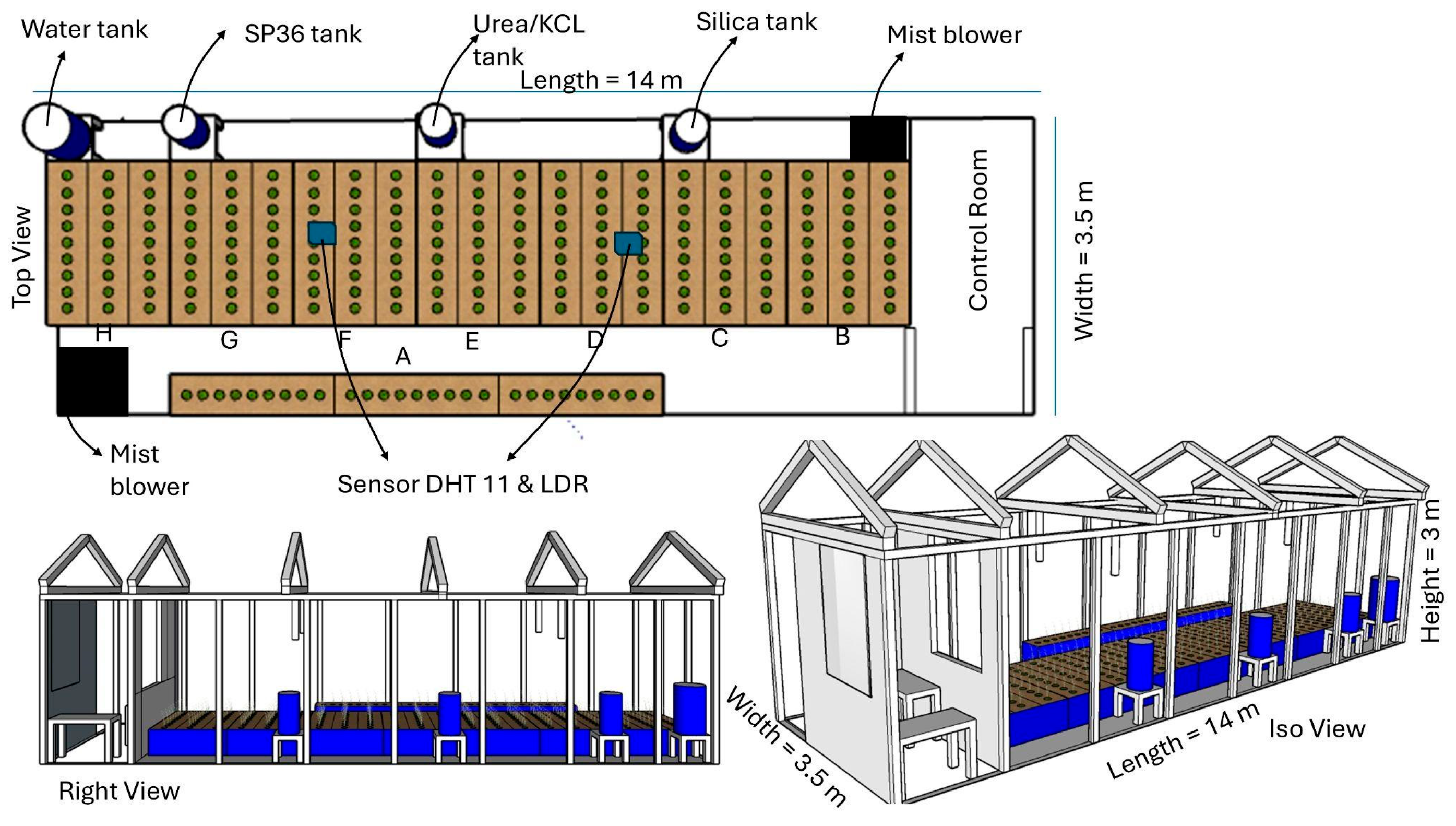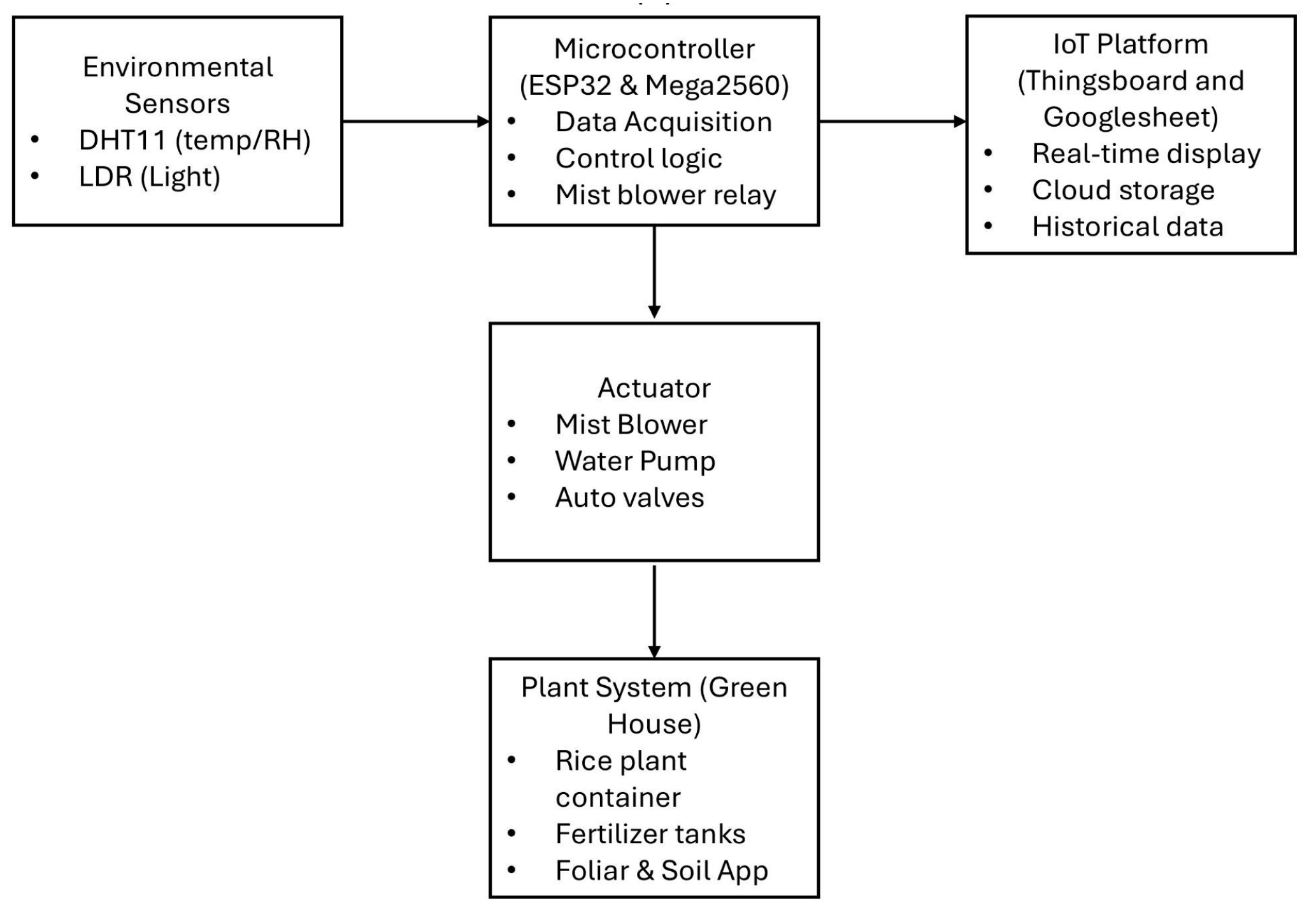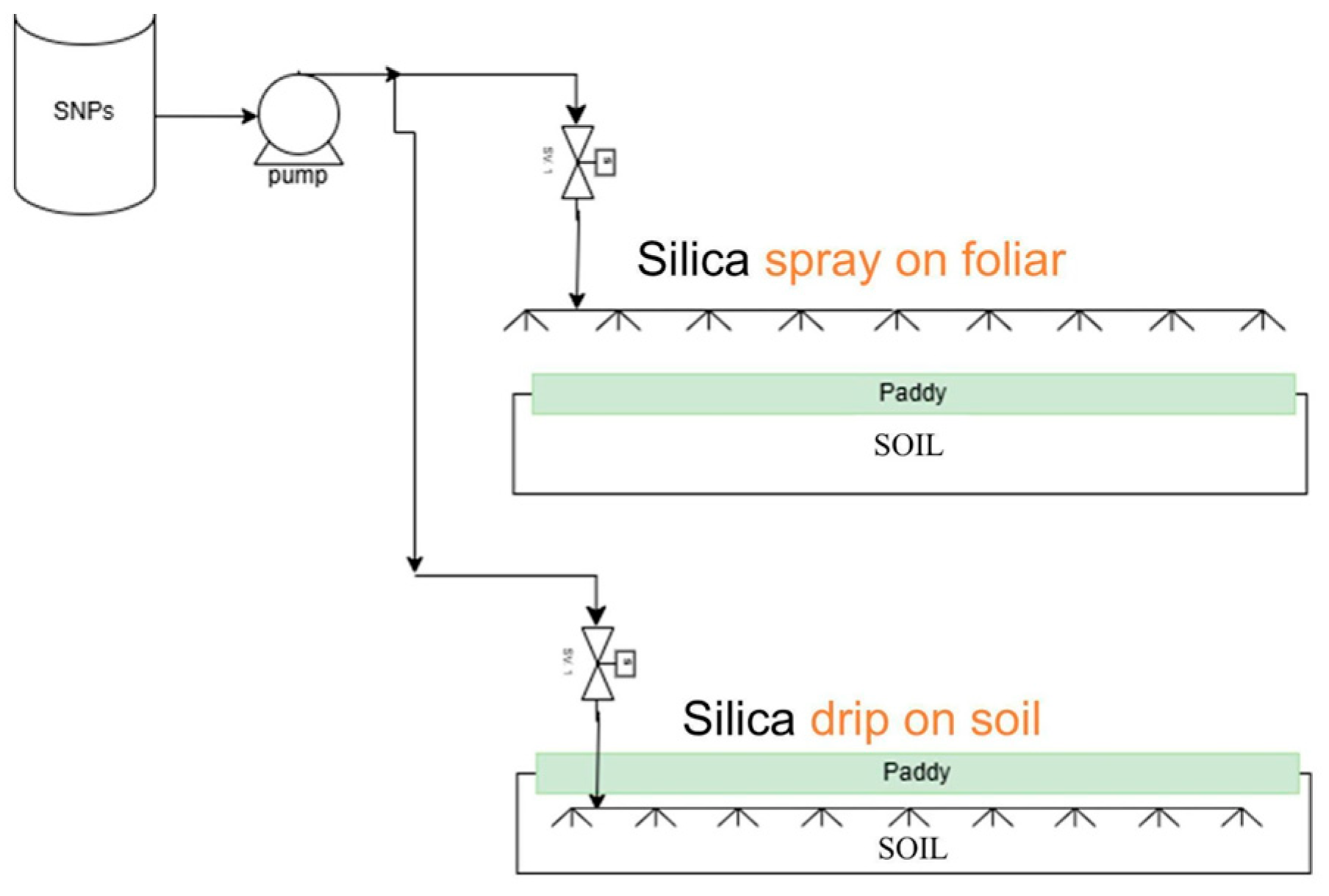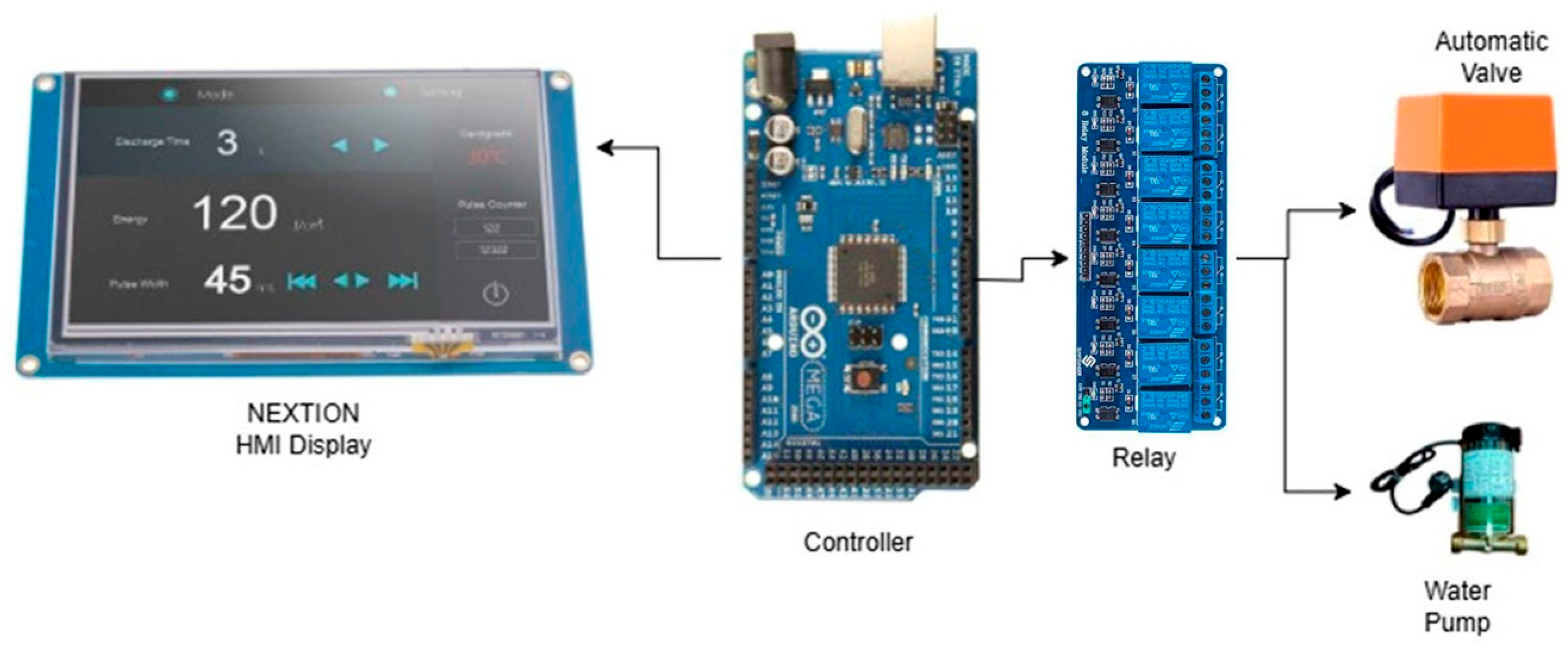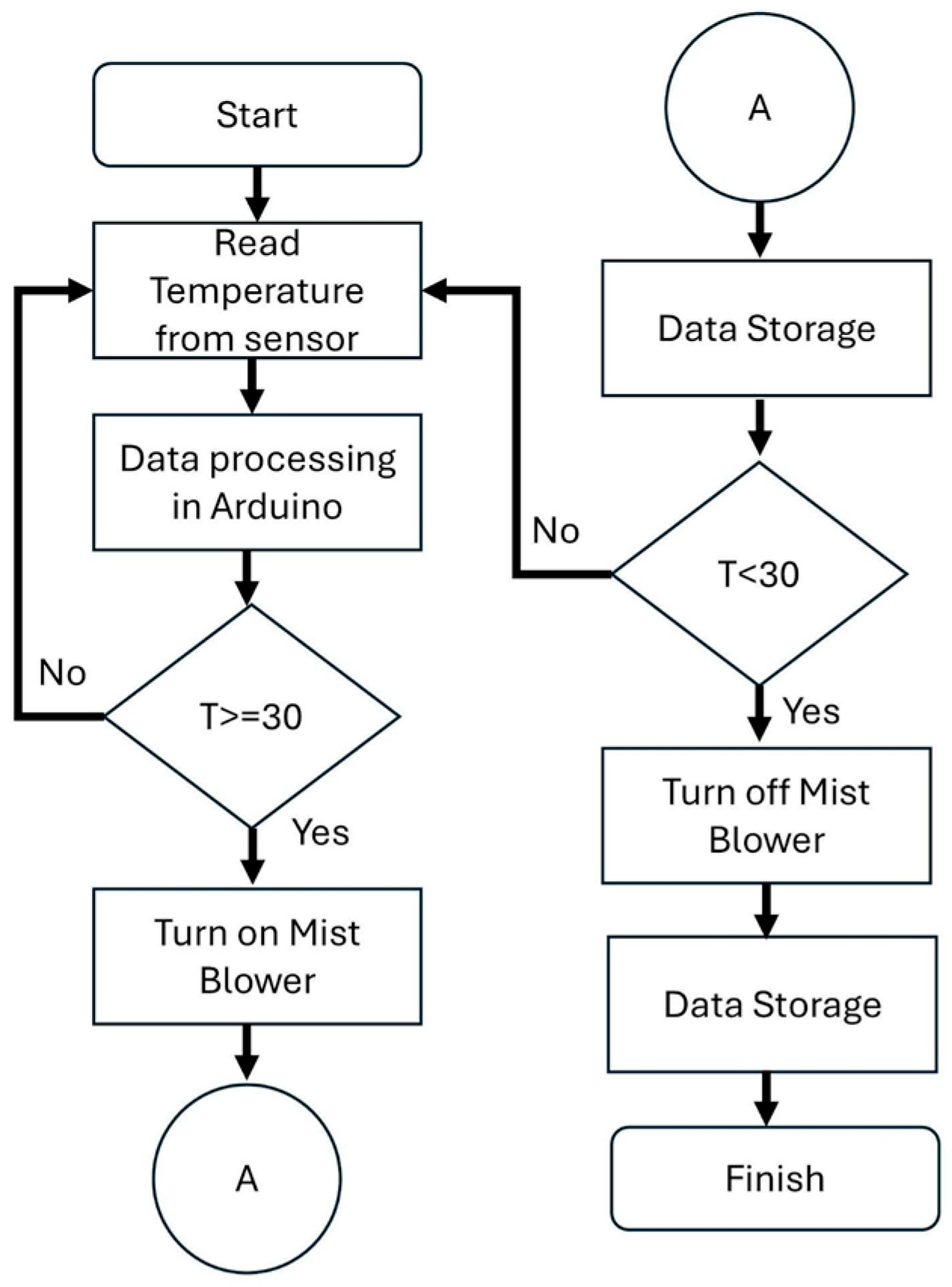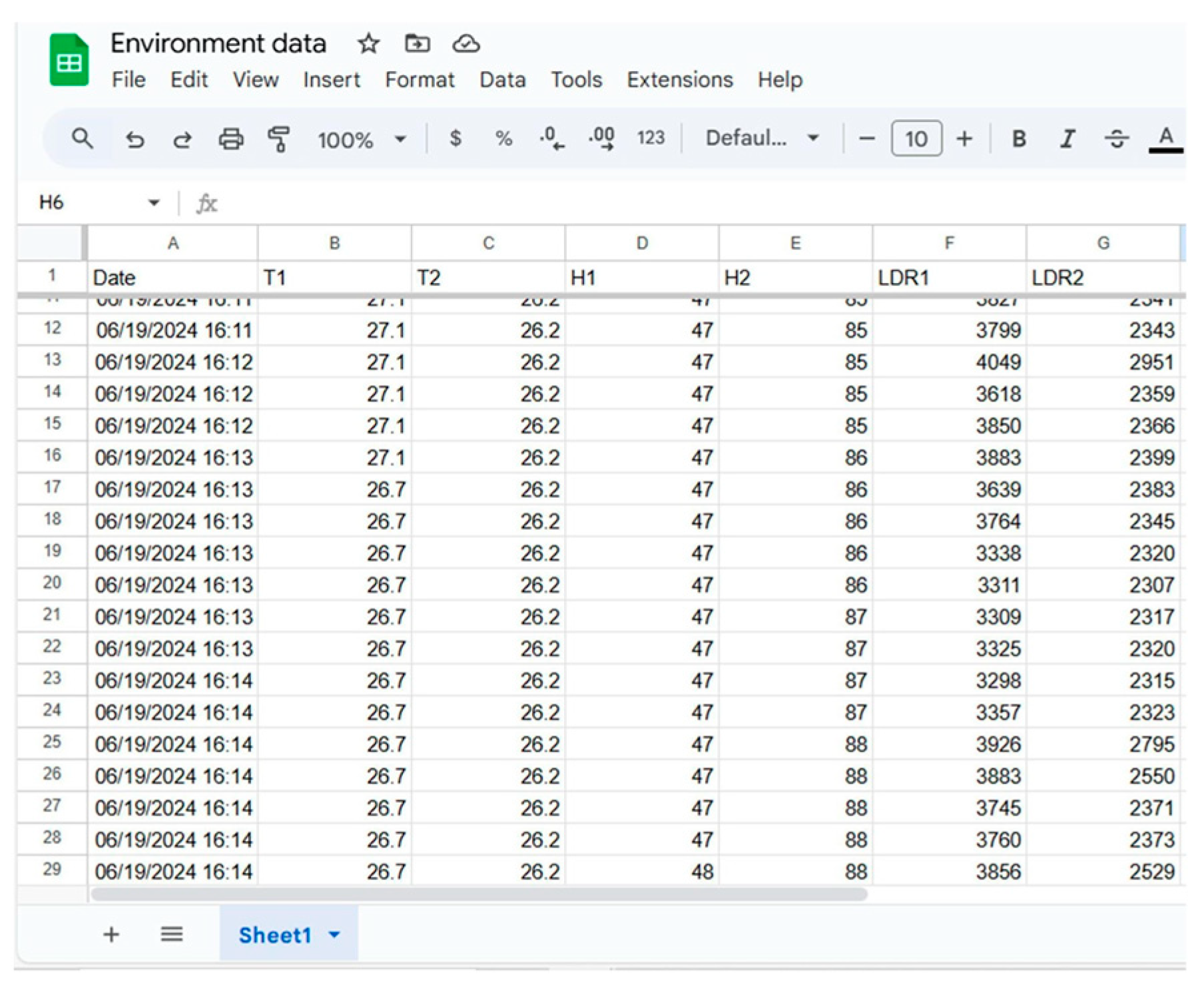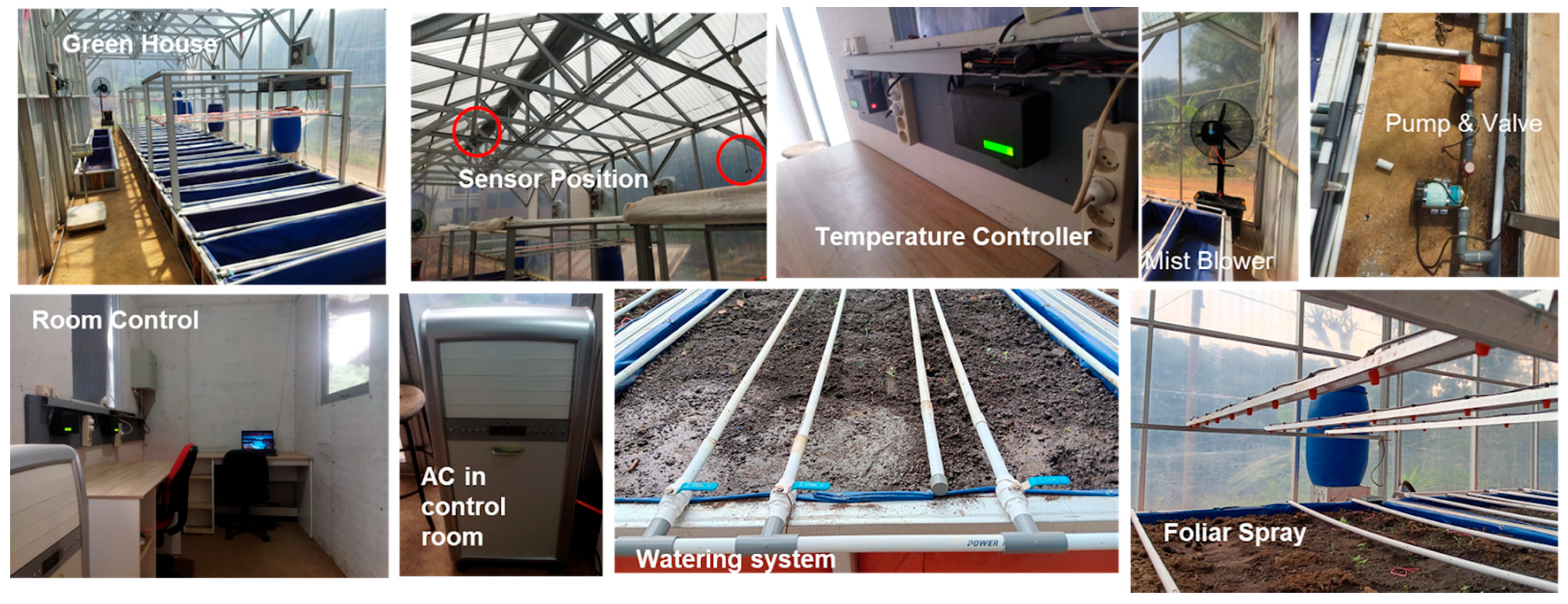1. Introduction
Global demand for rice has continued to rise in recent years, prompting the need for innovations in agricultural practices to ensure sustainable and efficient production. Traditional rice cultivation is challenged by unpredictable weather, pest infestations, and limited resource availability, all of which can adversely affect crop yield and quality. To overcome these limitations, the integration of technology into agriculture, particularly through smart farming systems, has emerged as a promising solution. Smart farming leverages Internet of Things (IoT) technology, automation, and data analytics to enhance agricultural efficiency, optimize resource management, and improve crop productivity [
1,
2].
Recent developments in smart farming systems have introduced advanced sensor technologies, automated control mechanisms, and real-time data processing capabilities [
3]. IoT-enabled greenhouses are specifically designed to monitor and regulate environmental parameters such as temperature, humidity, and soil moisture, thereby creating optimal conditions for plant growth [
4]. These systems often incorporate machine learning algorithms to interpret data and generate actionable insights, supporting better decision-making and resource allocation [
5]. Furthermore, improvements in wireless communication and cloud computing have enabled seamless integration of IoT devices, forming a responsive and interconnected agricultural ecosystem [
6,
7].
The convergence of IoT and artificial intelligence (AI) technologies has significantly advanced smart agriculture. In greenhouse applications, IoT systems integrate diverse sensors and communication protocols to optimize crop production and resource efficiency [
1]. AIoT enhances intelligent decision-making, predictive analytics, and real-time monitoring [
2]. Despite challenges such as data security and infrastructure costs, IoT continues to drive precision farming and smart irrigation [
3]. Hardware and communication innovations contribute to improved productivity and sustainability [
4], while IoT applications in early fire detection and water management bolster agricultural resilience [
6,
7]. Nonetheless, economic and technical barriers remain in deploying smart sensors across agricultural settings [
8,
9,
10,
11,
12]. The integration of AI and IoT supports enhanced data analysis and decision-making in precision agriculture [
13,
14,
15,
16,
17,
18], with ongoing research highlighting the transformative potential of IoT in improving efficiency, reducing resource consumption, and increasing yields [
19].
Despite these advancements, several gaps persist in the development of intelligent farming systems. High implementation and maintenance costs pose challenges for small-scale farmers [
3], and interoperability issues among IoT devices hinder widespread adoption due to the lack of standardized protocols [
2]. Moreover, long-term studies are needed to assess the impacts of IoT-based agriculture on crop performance, soil health, and environmental sustainability [
4,
20].
In parallel, nano-silica has emerged as a promising fertilizer, with foliar spraying proving more effective than soil or root application. Foliar application enhances rice plant height and biomass under both normal and stress conditions [
21], as nano-silica is absorbed through leaf apoplast and distributed efficiently [
22]. Soil application, by contrast, suffers from adsorption, desorption, and polymerization reactions influenced by concentration and pH, leading to significant losses and higher dosage requirements [
23]. Foliar spraying also boosts proline levels and antioxidant enzyme activity, improving tolerance to abiotic stress [
22], particularly in saline and alkaline soils [
24].
However, to rigorously evaluate the comparative effectiveness of these application methods, a precision-controlled farming system is essential. Most existing greenhouse systems are designed for production or simulation, not for structured experimentation. This study addresses that gap by developing an IoT-equipped smart greenhouse system specifically designed as a comparative testing platform. With automated temperature control and humidity regulation, the system enables parallel testing of nano-silica fertilizer via soil and foliar application under identical environmental conditions. This transforms the greenhouse into a valid and replicable research environment, capable of supporting experimental agronomy and input optimization.
Previous IoT-based greenhouse systems often lacked experimental flexibility, suffered from limited sensor integration, and were designed primarily for production rather than research. These limitations motivated the development of our system, which integrates real-time monitoring, automated control, and modular treatment zones. The objective of this study is to evaluate the effectiveness of nano-silica fertilizer applied via foliar and soil methods under controlled conditions. We hypothesize that foliar application will yield superior plant growth due to better nutrient absorption. Key contributions of this work include development of a modular IoT-enhanced greenhouse for rice experimentation, integration of real-time sensor data with automated control systems, comparative evaluation framework for fertilizer application methods, and validation of sensor accuracy and environmental stability.
Several studies have explored IoT applications in agriculture, including greenhouse automation and smart irrigation. However, most systems focus on production optimization rather than structured experimentation. For example, previous greenhouse designs have incorporated temperature and humidity control but lacked comparative treatment zones for evaluating input strategies [
1,
2,
3,
4]. Other implementations of sensor-based irrigation systems often omit validation of sensor accuracy, which is critical for reliable environmental control [
5,
6,
7]. In contrast, our system introduces a dual-purpose design with replicated treatment containers, validated sensors, and real-time cloud monitoring. Components such as the ESP32 microcontroller, Thingsboard platform, and mist blower control were either newly implemented or modified to support experimental rigor.
Accordingly, this study seeks to address two main research questions. The first concerns the design and performance of an IoT-enabled smart greenhouse capable of maintaining precise and stable environmental conditions to support structured agronomic experimentation. The second focuses on evaluating the system’s capability to facilitate controlled comparative experiments—specifically, assessing the differences between foliar and soil applications of nano-silica fertilizer at varying dosages (100, 200, and 300 kg/ha) on rice plants under identical environmental conditions. To rigorously compare the effectiveness of nano-silica fertilizer applied via foliar and soil methods, a precision-controlled environment is essential. The IoT-enabled greenhouse developed in this study provides such a platform by maintaining uniform temperature and humidity, also monitoring light intensity across treatment zones. This allows for direct attribution of plant response differences to the fertilizer application method rather than environmental variability. The integration of IoT technology thus plays a critical role in ensuring experimental validity and repeatability. By integrating advanced technologies into a structured experimental framework, this research contributes to the development of sustainable, efficient, and data-driven rice farming research practices. The system also holds potential for broader applications, including testing various fertilizer formulations, optimizing dosage and timing, and enabling predictive modeling of plant responses through future integration with machine learning.
Unlike most previous IoT-based greenhouse systems that mainly focus on production optimization or environmental control, this study introduces a dual-purpose IoT-enabled greenhouse platform specifically designed for comparative agronomic experimentation under identical environmental conditions. The system combines validated environmental control precision, maintaining temperature (20–36.5 °C) and humidity (10–85% RH) with high sensor accuracy (0.4% ± 0.11 °C and 0.77% ± 0.5% RH)—with a modular treatment structure that allows for parallel evaluation of foliar and soil fertilization methods. Furthermore, the experiment integrates a dosage optimization framework (100, 200, and 300 kg/ha) for both application modes, demonstrating how the platform can be extended to future machine learning-based predictive modeling of dosage–response relationships. This combination of real-time control precision and structured comparative design establishes a novel, replicable, and data-driven experimental platform for smart farming research.
2. Design of Control and Monitoring System
2.1. Design of Greenhouse Smart Farming System
The research scenario is a test rice plant with an integrated greenhouse system with an IoT-based instrumentation system. The Greenhouse was built according to standards and is carried out in the design and build stages. The design begins with designing the greenhouse according to standards referring to the minimum greenhouse standards of the Ministry of Agriculture of the Republic of Indonesia as shown in
Figure 1. The greenhouse dimensions (14 m × 3.5 m) and flow rates for irrigation (7.7 L/min for drip, 6.5 L/min for foliar spray).
Figure 2 shows the Integrated Block Diagram of a greenhouse system that integrates environmental sensors (DHT11 for temperature/RH, LDR light sensor), ESP32/Mega2560 based microcontroller, IoT platform (Thingsboard and Google Sheets) for real-time visualization, cloud storage, and historical data. DTH11 sensor data is used to control the mist blower actuator, while the water pump actuator, automatic valve are used as actions in the fertilization and irrigation process which then affect the planting system (rice plant containers, fertilizer tanks, and leaf and soil management).
The greenhouse design is divided into two rooms: the control room and the planting room. In the planting room, there are 8 containers and 4 drums (one 200 L drum, three 120 L drums). These containers are used for various rice plant treatments, while the drums are filled with fertilizer and water for irrigation and fertilization. Each container is divided into 3 partitions, forming 3 rows. Each row contains 10 clumps of rice, with each clump containing 3 rice seeds. The containers and drums are designed in such a way that they can drain water and fertilizer easily. The drum containing water for irrigation is placed with 1 automatic valve that can be turned on by Arduino Mega2560 with each end of the pipe adjusted so that the flow is the same each time it enters the container. For drums containing urea, sp36 and kcl, 7 automatic valves are placed that can be turned on by Arduino Mega2560 with each end of the pipe adjusted so that the flow is the same each time it enters the container through the soil. Meanwhile, for the drum containing silica fertilizer, 3 automatic valves are placed which have also been adjusted to the fertilization treatment in each container (through leaves or roots). The irrigation and fertilization design can be seen in
Figure 3.
Irrigation and fertilization used a pump from the tank by setting the duration of the automatic valve opening and the duration of the pump on. The treatment was divided into 3 experimental sections: root application, foliar application, and control. The Greenhouse piping design enables water and fertilizer spray management shown in
Figure 3. The planting scenario was divided into 8 treatments, with Container A serving as the absolute control (no fertilizer), while Container H received only NPK fertilizer. Containers B through G tested the silica treatments: B (foliar application of 100 kg/ha), C (soil application of 100 kg/ha), D (foliar application of 200 kg/ha), E (soil application of 200 kg/ha), F (foliar application of 300 kg/ha), and G (soil application of 300 kg/ha). Crucially, to isolate the effect of silica, all treatments from B through H received identical standard doses of NPK fertilizer applied to the soil (300 kg/ha of Urea, 200 kg/ha of SP-36, and 100 kg/ha of KCl). Each container was further divided into three sections, with each section containing 10 rice plants and forming one replication. This design ensured that each treatment combination was replicated three times (a total of 30 plants per treatment).
The supporting schematic design for the greenhouse irrigation process is shown in
Figure 4. The design showed a diagram of the irrigation process through the roots and leaves. Water through the leaves with a sprayer. Irrigation and fertilization systems in rice crops are designed to be supported by instrumentation and IoT systems. Instrumentation and IoT-based systems can help users control the amount of irrigation and fertilization in specific doses depending on the planting substrate plot and its treatment. Plant treatment is carried out in two parts, namely, through the roots (drip) and leaves (foliar spray). Meanwhile, the dosage for plants is divided into four dosages: low, medium, high and control doses.
In tank one, which contains silica nanoparticles (SNPs) with different nano-silica concentrations (100, 200, 300 kg/ha), solution pH (6.5), and application rates (7.7 L/min for foliar spray, 6.5 L/min for soil irrigation), both irrigation and foliar spray schemes will be delivered from this tank. Irrigation is alternated during the fertilizer application process. Then, the other two tanks contain standard fertilizers (urea, KCl, etc.) and are applied by the flood method. The fourth tank contains only water, also applied by the flood method. The application of SNP fertilizers is developed by spraying with a nozzle.
Greenhouse Smart Farming System using sensor systems to measure temperature, humidity, and sunlight intensity for optimizing plant growth control as shown in
Figure 5. Where this temperature value is used as a control parameter to turn on the mist blower. By precisely regulating those environmental factors in real time can enable precise management of environmental conditions, which leads to improved crop quality, increased yields, and resource efficiency. The system used consists of an ESP32 as the microcontroller built with Wi-Fi module, DHT11 sensor module for measuring temperature and environmental humidity, LDR sensor module SEN-0012 for measuring sunlight intensity and mist blower with SSR driver as a tool that will turn on if the greenhouse temperature becomes too hot. The measurement results from all sensors can be monitored and viewed in real time on the display located in the greenhouse control room and are stored in the cloud based on the Thingsboard and Googlesheet application using communication protocols MQTT for telemetry to Thingsboard and HTTP for Googlesheet access.
Thingsboard and Google Spreadsheet use a batch transmission method with a fixed interval every 3 min. For Thingsboard, this is done through the MQTT protocol, and for spreadsheets, it is done through HTTP/HTTPS. First, data from sensors is collected and then sent all at once in one request. The end-to-end latency for MQTT is about 200 ms, but for TLS handshake connections with Google Sheets, it can take longer depending on network conditions (between 1 and 3 s). This means that the system can respond almost in real time, which is an important aspect for precision agriculture’s dynamic environmental control. These improvements make sure that the smart greenhouse system not only gathers accurate data but also sends it quickly and reliably, which helps both scientific research and day-to-day operations.
In addition, the Greenhouse Smart Farming System also uses an Arduino Mega2560, Automatic Valve, Relay module driver and Nextion HMI display (
Figure 6) to apply irrigation flow from the tank using a water pump. Fertilizer application is regulated based on the time when the pump flow rate is 7.7 L/minute for leaf spraying and 6.5 L/minute for soil irrigation.
2.2. Sensors
2.2.1. Temperature and Humidity Sensor
The DHT11 temperature and humidity sensor has a temperature and humidity sensor complex with a calibrated digital signal output. By using exclusive digital signal acquisition technology as well as temperature and humidity sensor technology, it ensures high reliability and excellent long-term stability. This sensor includes a resistance component for humidity measurement and an NTC temperature measurement component and is connected to a powerful 8-bit microcontroller, which provides excellent quality, fast response, anti-interference capability and cost-effectiveness.
Each DHT11 element is rigorously calibrated in the laboratory, making the humidity calibration extremely accurate. The calibration coefficients are stored as programs in OTP memory that are used by the sensor’s internal signal detection process. The single-wire serial interface enables quick and easy system integration. Its small size, low power consumption and signal transmission distance of up to 20 m make it the best choice for various applications, even the most demanding ones. The component is a single row 4-pin package. The connection is convenient, and special packages can be provided depending on the user’s needs. The DHT11 sensor module provides a temperature range from 0 °C to 50 °C and a humidity range from 20% to 90%, with high reliability due to factory calibration. The DHT11 is easy to connect with microcontrollers like Arduino and Raspberry Pi [
25].
2.2.2. Light-Dependent Resistance (LDR) Sensor
A cost-effective digital and analog sensor module that can measure and detect light intensity is the LDR sensor module SEN-0012. Another name for this sensor is photoresistor sensor. The light-dependent resistor (LDR) integrated into this sensor supports light detection. There are four connections on this sensor module. where the pins “DO” and “AO” stand for the digital and analog output, respectively. When there is no light, the performance of the module increases, and when there is light, it decreases. The sensitivity of the sensor can be changed using the integrated potentiometer.
The LDR sensor module consists mainly of the LDR, LM393 Comparators, Variable Resistor (Trim-pot), Power LED, and output LED. The LDR (or light-dependent resistor) is a type of variable resistor. It is also called a photoresistor. The light-dependent resistor (LDR) works on the principle of “photoconductivity”. The LDR changes according to the intensity of light falling on the LDR. As the light intensity on the LDR surface increases, the LDR decreases and the element conductivity increases. As the light intensity on the LDR surface decreases, the LDR increases and the element conductivity decreases.
The LDR sensor module has an integrated variable resistor or potentiometer. This variable resistor is preset to 10 kΩ. This sets the sensitivity of this LDR sensor. Rotate the preset knob to adjust the sensitivity of light intensity detection. If we rotate the preset knob clockwise, the sensitivity of light intensity detection will increase. If it is rotated counterclockwise, the sensitivity of light intensity detection will decrease [
26].
2.3. Control and IoT System
2.3.1. Control System
The temperature control system utilized a SSR (Solid State Relay) module that opens and closes a switch due to an input signal applied to the control circuit. The SSR module connects the DC+ terminal to the positive pole of the 5 Volt power supply. Then, DC- terminal connects to the negative pole of the power supply. The CH terminal serves as the relay module’s signal trigger terminal, which is connected to the digital output of Arduino esp32. The normally closed (NC) SSR was connected to an AC source, and the SSR’s COM pin was connected to the mist blower. The input signal is the temperature read from the Arduino. When the temperature is more than 30 °C, the Arduino sends the signal LOW to the SSR, activating the SSR and allowing for the current to flow through the circuit. When the temperature is less than 30 °C, the Arduino will send a HIGH signal to the SSR, then the circuit closes. The control flow chart of the system can be seen in
Figure 7.
Figure 8 shows a block diagram of the temperature room control system. The controller will ensure that the temperature of the greenhouse does not exceed 40 °C so that the set point temperature is set at 30 °C to turn on the blower.
Watering and fertilizing the planting medium are measured using a timer to determine the flow rate in units of time or the flow rate of the liquid (
Figure 9). The flow rate time of the liquid to be distributed to each planting medium is used as the delay time for each automatic valve or solenoid valve (SV) to activate the ON/OFF control. Thus, the liquid is distributed to only one SV at a time (and so on) based on the delay time.
Figure 10 shows the flow diagram for controlling the on-off of a water pump, where the control process starts from determining the delay time and selecting the valve via the TFT screen, then the controller will continue the process.
2.3.2. Hardware Description of IoT System
The ESP32 Wi-Fi module enables the system to connect to a wireless network. The algorithm used by the ESP32 to retrieve data from the DHT11 and LDR sensors, then control the temperature by turning the mist blower on or off, and also to send the data to Thingsboard and Google Sheets, is shown in
Figure 11. After integrating the library, the humidity, light intensity, and temperature variables as control variables, Wi-Fi access, and cloud configuration access are defined. Then, the ESP32 reads the sensor measurement data and sends it automatically and without external interference to Thingsboard and Google Sheets via a WLAN AP. The open-source Thingsboard IoT Application Program Interface (API) provides an Internet of Things platform that uses the MQTT publish-subscribe network protocol to store and retrieve temperature, humidity, and light intensity data. The three main actors in the message exchange process are the publisher, the MQTT broker, and the subscriber [
27,
28]. Thingsboard and Google Spreadsheet use a batch transmission method with a fixed interval every 3 min. For Thingsboard, this is done through the MQTT protocol, and for spreadsheets, it is done through HTTP/HTTPS. First, data from sensors is collected and then sent all at once in one request. The end-to-end latency for MQTT is about 200ms, but for TLS handshake connections with Google Sheets, it can take longer depending on network conditions (between 1 and 3 s). This means that the system can respond almost in real time, which is an important aspect for precision agriculture’s dynamic environmental control. These improvements make sure that the smart greenhouse system not only gathers accurate data but also sends it quickly and reliably, which helps both scientific research and day-to-day operations. Reliability testing was conducted over 7 days and showed 96.5% successful data transmission, with an average latency of 200 ms.
2.3.3. Sensor Characteristics
Sensor calibration was performed prior to deployment. The DHT11 sensor readings were compared with a calibrated Krisbow temperature and humidity sensor (±1 °C, ±5% RH), while the LDR sensor was validated against a Sanwa mobiken LX2 illuminance meter (±(5% + 1) below 3000 lx; ±(7.5% + 1) 3000 lx or higher). Calibration tests were conducted over a 24 h period under Greenhouse conditions.
Table 1 shows the characteristics of the sensor. DHT11 showed an average deviation of 0.4% (±0.11 °C) and 0.77% (±0.5%RH), while the LDR sensor maintained a deviation within ±9.9% of reference values. These results confirm the sensors’ reliability for environmental monitoring in the greenhouse.
2.4. Planting Design
During the growth period, standard urea fertilizer was applied three times, at 7, 21, and 36 days after planting. SP36 fertilizer was applied once, at 7 days after planting, while KCL fertilizer was applied twice, at 7 and 36 days after planting. Meanwhile, the application of silica nanoparticle (SNP) fertilizer was carried out 2 times, at 56 and 63 days after planting. The SNP application was regulated based on different doses, namely, low, medium, high, and control, where the concentrations used were 100, 200, and 300 kg/ha. The application was also carried out with two different treatments: root (flood irrigation) and foliar (foliar spray). Therefore, 8 planting media were needed to conduct the treatment test on these plants. Based on statistical treatment calculations, the number of plants to be tested for each planting medium was 10 plants with 3 replicates (30 plants).
The study employed a Randomized Complete Block Design (RCBD) to evaluate silica fertilizer efficacy. The experiment utilized eight planting containers (labeled A to H, each measuring 1.5 m × 2.0 m) arranged in a fixed sequence, with each container representing a distinct treatment. The treatments were systematically assigned as follows: Container A served as an absolute control (no fertilizer), while Container H received only NPK fertilizer. Containers B through G tested the silica treatments: B (foliar application at 100 kg/ha), C (soil application at 100 kg/ha), D (foliar at 200 kg/ha), E (soil at 200 kg/ha), F (foliar at 300 kg/ha), and G (soil at 300 kg/ha). Crucially, to isolate the effect of silica, all treatments from B to H received an identical, standardized dose of NPK fertilizer applied to the soil (300 kg/ha Urea, 200 kg/ha SP-36, and 100 kg/ha KCl). Each container was subdivided into three sections, with each section housing 10 rice plants and constituting one replica. This design ensured that each treatment combination was replicated three times (totaling 30 plants per treatment). While the assignment was systematic, this approach effectively controlled for spatial variation and provided a robust framework for the comparative analysis of silica fertilizer effects within the IoT-controlled environment.
4. Conclusions
This study successfully designed and implemented a smart greenhouse system equipped with IoT technology to support precision rice cultivation and structured experimentation. The system demonstrated consistent performance in monitoring and regulating key environmental parameters, temperature, humidity, and light intensity, ensuring optimal and stable growing conditions throughout the cultivation process. Beyond its role as a cultivation space, the greenhouse was purposefully developed as a comparative research platform, enabling parallel testing of nano-silica fertilizer application via foliar and soil methods under identical environmental conditions. This design minimizes external variability and enhances the reliability of treatment evaluation, addressing a critical gap in agricultural experimentation where environmental inconsistency often limits the validity of comparative studies. The successful deployment of this system highlights the potential of smart farming technologies to improve agricultural productivity, resource efficiency, and sustainability. It also demonstrates how traditional farming practices can be transformed through digital innovation, offering scalable and replicable models for both research and commercial use.
In conclusion, the IoT-enabled greenhouse system provides a robust foundation for future agricultural experimentation. Its precision control and data-driven architecture support advanced input testing, including dosage optimization and interaction studies, and open pathways for integration with predictive analytics—contributing meaningfully to the advancement of sustainable and intelligent food production systems.
This study successfully demonstrates the design and implementation of an IoT-enhanced greenhouse system capable of supporting precision-controlled rice cultivation. While the current focus is on validating the system’s environmental monitoring and control capabilities, agronomic results from the nano-silica fertilizer comparison are still under analysis and will be presented in a subsequent publication. The system’s modular design also allows for future integration with machine learning models to predict plant responses, paving the way for advanced smart farming applications. While the system demonstrates strong performance in environmental control and experimental flexibility, limitations include scalability to larger farms, initial setup cost, and reliance on stable internet connectivity. Also, we use ON/OFF control logic due to its simplicity and reliability in small-scale greenhouse setups. Future work will focus on evaluating the energy efficiency and long-term operational stability of the proposed IoT-enabled greenhouse system through extended monitoring experiments. We also acknowledge the current limitations and plan to incorporate advanced control strategies such as PID and fuzzy logic models in future iterations to enhance system responsiveness. Additionally, we aim to integrate AI-based decision models capable of predicting plant responses and optimizing fertilizer schedules using historical data. The scalability and adaptability of the system further open opportunities for deployment across various crop types and climatic conditions, supporting broader applications in precision agriculture.
